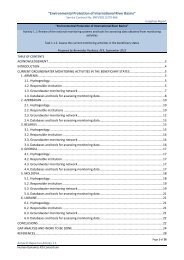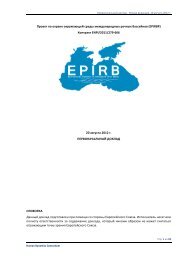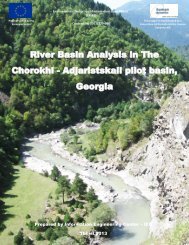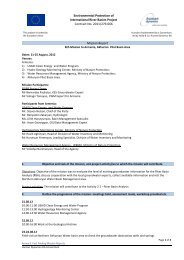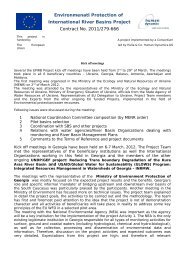Nokia Standard Document Template - Environmental Protection of ...
Nokia Standard Document Template - Environmental Protection of ...
Nokia Standard Document Template - Environmental Protection of ...
- No tags were found...
You also want an ePaper? Increase the reach of your titles
YUMPU automatically turns print PDFs into web optimized ePapers that Google loves.
4th Mission Report _KE3_Jan –Feb 20132) At least one extra local training course was submitted to each country, together with the associatedtraining materials.3) Training Certificates were submitted to the 19 delegates at the regional workshop. <strong>Template</strong>s havebeen also produced by KE3 for the other local workshops -an example is shown in Appendix 12.These certificates should be presented to all the participants, as a record <strong>of</strong> their training for inclusion ineach country’s ISO 17025 quality manual.Activity 1.6Georgia and Armenia both analyse for OCPs and Azerbaijan has the equipment. Both Georgia andArmenia need to make changes with their sampling bottles, extraction and analysis procedures.Azerbaijan needs to commission the GLC and develop the method, which the supplier can assist with.The KE3 worked with the analysts to provide further training and making recommendations to developand improve the methods. One key material prevented the KE3 from completing his training and this wasthe OCP mixed standard, it is essential for the Project to obtain this, so that the countries can completethis analysis to produce credible results following the JFS.The Batumi Coastal Laboratory in Georgia had some serious problems with their Atomic AbsorptionSpectrophotometer and Fluorescence Spectrophotometer, which are important to analyse WFDparameters. The KE3 spent three days working with the senior staff to resolve these problems.The Fluorescence Spectrophotometer’s problems were resolved so that it was operational. The AtomicAbsorption Spectrophotometer problem was extensively diagnosed has been confirmed to be a lampenergy detection problem.The Hydrobiological equipment has been installed in each laboratory and all countries have been trainedin the sampling <strong>of</strong> BMIs. However, they have requested further training on the identification <strong>of</strong> the BMIsand the procedures for processing the results. This should be undertaken by a non-key specialist.Furthermore as a tool to process the results and to complete the training the countries require aspecialised s<strong>of</strong>tware called Aquabiobase, which was demonstrated at the regional workshop.Outputs1) The KE3 has provided training, support and recommendations to improve the OCP analysis in eachcountry. The details can be referred to by the stakeholders in this mission report.2) At Batumi NEA the KE3 managed to make the Fluorescence Spectrophotometer operational after it notbeing used since new for over 5 years. The staff were submitted hands-on training and were confident inusing the equipment to analyse petroleum oils. Recommendations were made t<strong>of</strong>urther develop the application <strong>of</strong> this apparatus.3) Within this report is a list <strong>of</strong> the issues addressed the problem <strong>of</strong> the AAS, which could be submitted tothe manufacturer Perkin Elmer to resolve the problem quickly.4) The KE3 has been working with the Project Managers to produce the ToR for the non-key expertsrequired for the BMI analysis.Activity 2.2The KE3 worked with the other Key Experts in Armenia and Azerbaijan in developing the delineation <strong>of</strong>the water bodies at risk. To date only Armenia had submitted information to start this process (Appenix 9Page 18 <strong>of</strong> 36




